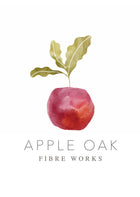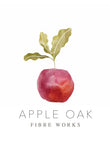

ORGANIC COCHINEAL DYE
COCHINEAL DYE ~ Dye colours red, pinks to purples
Origin: Canary Islands, Spain. Organically farmed and processed by Canaturex
I am so delighted to have finally found some organic Cochineal. Lorenzo is one of the very first offering fully traceable Cochineal grown to organic principals.
Cochineal, a powerful dye sourced from tiny insects that feed on cacti, produces stunning shades of purple, red and pink. With just one dye bath, this incredible insect can create a range of hues, from deep, rich reds to delicate, fairy-like pinks. It is derived from the Dactylopius species of insects, and its body contains 19-22% carminic acid.
*To make one kilogram of cochineal dye, it takes about 80,000 to 100,000 insects.
Excellent colour fastness is guaranteed.
---------------------
Recipe for Wool Fibres: Downloadable PDF
Recipe For Plant Fibres: Downloadable PDF
Basic recipe:
6% Cochineal
Wool yarn mordanted with Alum 10%
Soak Cochineal in Water overnight
blend using a stick blender
Add dye to dye bath
Bring to a simmer
Remove any black tar like bubbles
Strain through a cloth and keep to the side
Add yarn to bath simmer for one hour.
Add dye bag to second and any following dye baths.








SAFFLOWER DYE
SAFFLOWER DYE (Carthamus tinctorius)
Dye Colour: Soft Yellow and Red | Country of Collection: Iran
Safflower, a thistle-like plant native to arid environments, offers a stunning soft yellow and red dye, making it a great choice for dyeing natural fibres like linen and cotton. While it produces a warm red, the process to extract this colour is intricate, requiring extended soaking, kneading, and rinsing. By adjusting the pH and repeating these steps, you can achieve a richer red tone on plant-based fibres. This lengthy process is well worth the effort for those seeking vibrant hues, especially for linen, cotton, and other plant fibres.
Colour Fastness: Poor to Medium
Colour Outcomes by WOF Ratio:
- 100% WOF Dye (Safflower): Soft yellow tones for protein fibres.
- After removal of the yellow dye: Richer red tones for plant-based fibres.
Basic Recipe for Yellow:
Ingredients:
- 100g Safflower
- 100g mordanted yarn/fibre (Alum 15g)
Instructions:
- Soak the Safflower dye in water overnight.
- Bring the dye pot to a simmer for 1 hour.
- Strain the dye through cloth and add mordanted yarn or fibre to the dye bath.
- Simmer for 1 hour and rinse to reveal a soft yellow colour.
Notes:
- Yellow is ideal for protein fibres, red for cellulose only.
- For richer red tones: Repeat soaking, kneading, and rinsing in a high pH environment.
- Safflower produces a softer, warm yellow dye but can yield red after more intensive preparation.
Embrace the natural beauty of Safflower dye and create stunning, soft yellow and red tones for your textile or paper projects.
Join The Natural Dyers & Growers Academy to share your experiences and get support from fellow growers.


